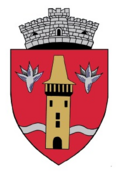Hoghilag
|
Hoghilag Halvelagen Holdvilag |
||||
|
||||
| Basic data | ||||
|---|---|---|---|---|
| State : |
|
|||
| Historical region : | Transylvania | |||
| Circle : | Sibiu | |||
| Coordinates : | 46 ° 14 ' N , 24 ° 37' E | |||
| Time zone : | EET ( UTC +2) | |||
| Height : | 327 m | |||
| Area : | 52.13 km² | |||
| Residents : | 2,172 (October 20, 2011) | |||
| Population density : | 42 inhabitants per km² | |||
| Postal code : | 557100 | |||
| Telephone code : | (+40) 02 69 | |||
| License plate : | SB | |||
| Structure and administration (as of 2016) | ||||
| Community type : | local community | |||
| Structure : | Hoghilag, Prod , Valchid | |||
| Mayor : | Nicolae Lazar ( PSD ) | |||
| Postal address : | Str. Principală, no. 305 loc. Hoghilag, jud. Sibiu, RO-557100 |
|||
| Website : | ||||
Hoghilag ( German Halvelagen or Halwelagen , Hungarian Holdvilag ) is a municipality in the Sibiu district in Transylvania , Romania .
geography
Halvelagen extends along the north side of the valley of the Târnava Mare ( Great Kokel ). Directly neighboring villages are the small town Dumbrăveni ( Elisabethstadt ) in the west, the village Prod ( Pruden ) in the northeast, Laslea ( Lasseln ) in the southeast and Valchid ( forest huts ) in the south. Other neighboring larger localities are the city of Sighișoara ( Schäßburg ) located 20 kilometers to the east and the city of Mediaș ( Mediasch ) located 30 kilometers to the west .
history
Halvelagen was probably founded in the 14th century by the Transylvanian Saxons . The German name Halvelagen comes from the Hungarian name Holdvilag and probably means settlement of the moon . In the course of settlement, one of the fortified churches characteristic of Transylvania was also built in Halvelagen . The castle wall around the church and the steeple Halvelagens were demolished in the 17th century.
On one of the higher mountains around Halvelagen there was once a signal tower or a smaller castle (Pfaffenburg). In the 1970s, remains of sandstone steps and walls could still be found.
Around 1900, a large part of the Halvelagen emigrated to America. There they worked in steel mills and sausage factories around Chicago and Detroit, among other things . Halvelagen has had the status of a municipality since around 1900. Today around 1000 people live in Hoghilag. With the two cadastral communities of Prod and Valchid , there are more than 2000. In the years around 1960 there were around 500 Transylvanian Saxons, 250 Romanians and 250 Roma living in Halvelagen .
Younger past and present
After the fall of the Romanian dictator Nicolae Ceaușescu , almost all of Halvelagen's Saxons left their home community and moved to Germany.
The church organ was restored in Germany and then handed over to the Music Conservatory in Cluj-Napoca ( Klausenburg ). In the 1990s, the Halvelagner church administration sold one of the three tower bells of the Saxon church tower to a parish in the Hungarian-speaking Szekler region in the inner Carpathian arch.
In 2005 around 1,000 people lived in Halvelagen, including around 500 Romanians, around 500 Roma and 4 Saxons.
Attractions
- The Evangelical Church, built between 1828 and 1838, and the 36 meter high pointed tower next door, built in 1581 and renovated in 1796, are listed as historical monuments.
literature
- Anna Dengel, Ulrike Schinker (ed.): Halvelagen, where I was at home. Publishing house Transylvanian-Saxon Foundation, Munich 1998.
Web links
- Halvelagen at sevenbuerger.de
- Web presentation of the Halvelager hometown community
- Hoghilag at ghidulprimariilor.ro
Individual evidence
- ↑ 2011 census in Romania at citypopulation.de
- ↑ a b List of historical monuments of the Romanian Ministry of Culture, updated 2010 (Romanian; PDF; 7.10 MB)







